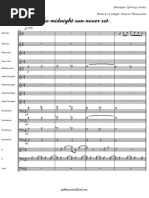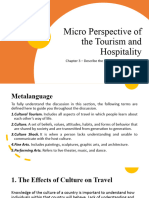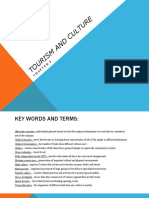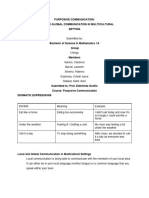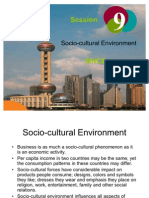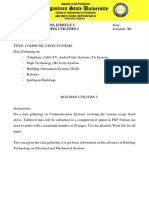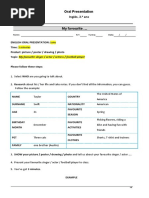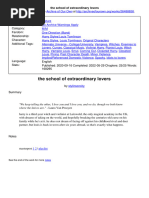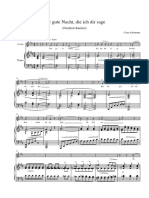0 ratings0% found this document useful (0 votes)
23 viewsMicro Week 6
Micro Week 6
Uploaded by
Bern ConcepcionThe document discusses how culture affects tourism and cultural tourism. It defines culture and explains how a lack of understanding of a host culture can lead to culture shock for tourists. It also discusses how cultural patterns change over time due to internal and external forces. The document emphasizes that cultural tourism is important for promoting cultural relations between countries. It lists several cultural factors, like art, music, handicrafts, that greatly appeal to tourists.
Copyright:
© All Rights Reserved
Available Formats
Download as PDF, TXT or read online from Scribd
Micro Week 6
Micro Week 6
Uploaded by
Bern Concepcion0 ratings0% found this document useful (0 votes)
23 views12 pagesThe document discusses how culture affects tourism and cultural tourism. It defines culture and explains how a lack of understanding of a host culture can lead to culture shock for tourists. It also discusses how cultural patterns change over time due to internal and external forces. The document emphasizes that cultural tourism is important for promoting cultural relations between countries. It lists several cultural factors, like art, music, handicrafts, that greatly appeal to tourists.
Copyright
© © All Rights Reserved
Available Formats
PDF, TXT or read online from Scribd
Share this document
Did you find this document useful?
Is this content inappropriate?
The document discusses how culture affects tourism and cultural tourism. It defines culture and explains how a lack of understanding of a host culture can lead to culture shock for tourists. It also discusses how cultural patterns change over time due to internal and external forces. The document emphasizes that cultural tourism is important for promoting cultural relations between countries. It lists several cultural factors, like art, music, handicrafts, that greatly appeal to tourists.
Copyright:
© All Rights Reserved
Available Formats
Download as PDF, TXT or read online from Scribd
Download as pdf or txt
0 ratings0% found this document useful (0 votes)
23 views12 pagesMicro Week 6
Micro Week 6
Uploaded by
Bern ConcepcionThe document discusses how culture affects tourism and cultural tourism. It defines culture and explains how a lack of understanding of a host culture can lead to culture shock for tourists. It also discusses how cultural patterns change over time due to internal and external forces. The document emphasizes that cultural tourism is important for promoting cultural relations between countries. It lists several cultural factors, like art, music, handicrafts, that greatly appeal to tourists.
Copyright:
© All Rights Reserved
Available Formats
Download as PDF, TXT or read online from Scribd
Download as pdf or txt
You are on page 1of 12
tourist and culture
Scope of the Presentation
describe the effects of cultures in travel;
clarify how cultural patterns are changed by internal and
external forces;
discuss the importance of cultural tourism; and
explain how each of these cultural factors contribute to
cultural tourism
the effects of culture on travel
Culture can be defined as “set of beliefs, values, attitudes, habits
, and form of behavior that are shared by a society and are
transmitted from generation to generation. A knowledge of the
culture of a country is important in order to understand how
individuals within that country will behave. Lack of
understanding and inability to communicate with the host
culture might result in a culture shock for the tourist. A Filipino
traveler who visits the United States for the first time may
experience culture shock in the open display of love and
emotions, the frankness in conversation, the permissive way
children interact with their parents, and the practice of allowing
aged parents to stay in the home for the aged.
the effects of culture on travel
Likewise, an American tourist in the
Philippines might be repelled by balut (cooked
duck egg w/ embryo) and the bagoong
(preserved salted fish) or may feel exasperated
by the Filipinos’ lack of punctuality or time
concept, and the use of euphemism and
circumlocution in contrast to American
frankness. Culture patterns are changed by
internal forces.
the importance of acaultural Tourism
Cultural tourism includes all aspects of travel in which
people learn about each other’s way of life. Thus,
tourism is an important means of promoting cultural
relations and international cooperation. Louis D’ Amore,
the past president of Canadin Travel Research
Association, once said, “These millions of daily person-
to-person encounters are potentially a powerful force
for improved relations among the people and nations of
the world, relations which emphasize a sharing and
appreciation of cultures rather than the lack of trust
bred by isolation.
CULTURAL FACTORS WITH
TOURIST APPEAL
In Tourism, there are cultural factors that appeal greatly to
tourists. These are art, music and dance, handicraft,
industry and business, agriculture, education, literature
and language, science, government, religion, food, and
drink, and history.
Include performing arts and fine arts. The former
A. ART refers to live theater, music, and dance, and the
latter includes painting, sculpture, graphic arts,
and architecture.
Example of performing arts are the Pangkat
Kawayan (bamboo orchestra) and the rondalla
group. Amorsolo’s and Francisco’s paintings and
the sculptura works of Michaelangelo are
examples of fine arts
B. Music and Dance
Music is a major source of enjoyment and satisfaction to tourists.
Evening entertainment, programs, concerts, and sound
production systems are greatly appreaciated by tourists.
Dancing, in its native or ethnic forms, is one of the most appealing
aspects of a country’s culture and can be presented as a tourist
attraction. The color, costumes, music, setting and skill of form
and execution add to the attraction. ethnic music and dancing are
part of the culture and should be used to entertain tourist.
*BAYANIHAN DANCE TROUPE OF THE PHIL *THE BALLET
FOLKLORICO OF MEXICO *THE RUSSIAN BOLSHOI BALLET *THE
FOLK DANCES OF EUROPEAN COUNTRIES *THE AFRICAN
DANCES *THAI DANCING *KABUKI DANCERS OF JAPAN.
C. Handicraft
To satisfy tourists, gifts and souvenirs for sale should be
manufactured in the country where the purchase is made.
Things to Remember
Add a main point Add a main point Add a main point
Elaborate on what Elaborate on what Elaborate on what
you want to discuss. you want to discuss. you want to discuss.
Add a main point Add a main point Add a main point
Elaborate on what Elaborate on what Elaborate on what
you want to discuss. you want to discuss. you want to discuss.
Our Team
Elaborate on what you want to discuss.
Name Name Name Name
Title or Position Title or Position Title or Position Title or Position
Thank you!
-to-action
nt or call
statem e
a closing
Write here.
You might also like
- Multicultural Diversity in The Workplace For The Tourism ProfessionalDocument57 pagesMulticultural Diversity in The Workplace For The Tourism ProfessionalMarkmarilyn89% (84)
- The Midnight Sun Never Set Arrangement Pascal ThouveninDocument8 pagesThe Midnight Sun Never Set Arrangement Pascal Thouveninoskar briland33% (3)
- AE6701 - Avionics NotesDocument83 pagesAE6701 - Avionics Notesparantn100% (1)
- Blues Harmonica Master Class by Jerry PortnoyDocument52 pagesBlues Harmonica Master Class by Jerry PortnoyThiagoAoki100% (6)
- GSFC-733-HARN-01 (Design and Manufacturing Standard For Electrical Harnesses)Document24 pagesGSFC-733-HARN-01 (Design and Manufacturing Standard For Electrical Harnesses)FernandoAdrián100% (1)
- Awal 2018 Ultimate Release Guide PDFDocument42 pagesAwal 2018 Ultimate Release Guide PDFanna92No ratings yet
- Semiconductors and Semimetals Infrared DetectorsDocument499 pagesSemiconductors and Semimetals Infrared DetectorsMohammed umar sheriffNo ratings yet
- Module 3 TOURISM AND CULTUREDocument7 pagesModule 3 TOURISM AND CULTURECarl Anthony P. Pilapil100% (1)
- Micro Module 3 Tourism and CultureDocument42 pagesMicro Module 3 Tourism and CultureMariel Domanico100% (1)
- Tourism and CultureDocument12 pagesTourism and CultureCevi HaroteraNo ratings yet
- Tourism and CultureDocument26 pagesTourism and CultureGILBOYNo ratings yet
- Module 2 Bstm 2a Group 2 MicroDocument9 pagesModule 2 Bstm 2a Group 2 MicroLyslie WP DaytoNo ratings yet
- Chapter 3 Tourism and CultureDocument7 pagesChapter 3 Tourism and CultureKristine Rose D. AgustinNo ratings yet
- School of Tourism and Hospitality ManagementDocument8 pagesSchool of Tourism and Hospitality ManagementAeron UmaliNo ratings yet
- Chapter 3Document20 pagesChapter 3dimplevecina09No ratings yet
- Chapter 3 Tourism and CultureDocument16 pagesChapter 3 Tourism and CultureJoan DardoNo ratings yet
- Chapter 6-Tourism and CultureDocument18 pagesChapter 6-Tourism and CultureRiza CatingogNo ratings yet
- Tourism and CultureDocument25 pagesTourism and CultureDenise PereñaNo ratings yet
- Chapter 3 TOURISM AND CULTURE AutosavedDocument51 pagesChapter 3 TOURISM AND CULTURE AutosavedRoy CabarlesNo ratings yet
- BSHM 85 Chapter 1 Understanding CultureDocument28 pagesBSHM 85 Chapter 1 Understanding Cultureshiene.salonNo ratings yet
- Lesson 3 - Tourism and CultureDocument3 pagesLesson 3 - Tourism and CultureShenn Silva RockwellNo ratings yet
- CHAPTER 6-Tourism and CultureDocument4 pagesCHAPTER 6-Tourism and CultureZeusNo ratings yet
- Chapter 3Document18 pagesChapter 3Janna Marie GeronimoNo ratings yet
- Tourism and Culture: Bachelor of Science in Tourism ManagementDocument5 pagesTourism and Culture: Bachelor of Science in Tourism ManagementAngela MendozaNo ratings yet
- Chapter 3 TOURISM AND CULTURE AutosavedDocument51 pagesChapter 3 TOURISM AND CULTURE AutosavedCha Garcia100% (4)
- Chapter 3Document10 pagesChapter 3Jocelyn Mae CabreraNo ratings yet
- Chapter - 1Document29 pagesChapter - 1Faith Gg100% (1)
- Module 4 - Cultures - 024616Document10 pagesModule 4 - Cultures - 024616cataloctocanmendiemaeNo ratings yet
- The Effects of Culture On TravelDocument1 pageThe Effects of Culture On TravelRachel repaldaNo ratings yet
- Tourism and Culture Chapter 3Document21 pagesTourism and Culture Chapter 3Quen AeiouNo ratings yet
- Multicultural DiversityDocument20 pagesMulticultural DiversityJovelle TugadeNo ratings yet
- Ch. 3 - Micro Perspective of The Tourism and HospitalityDocument9 pagesCh. 3 - Micro Perspective of The Tourism and HospitalityFrancine BalansagNo ratings yet
- Cook Islands - Personality and CultureDocument13 pagesCook Islands - Personality and CultureSándor Tóth100% (1)
- Ethnographic Influence Among Manobo Tribesmen in The PhilippinesDocument4 pagesEthnographic Influence Among Manobo Tribesmen in The PhilippinesFitz Gerald VergaraNo ratings yet
- Lesson-3 EditedDocument10 pagesLesson-3 EditedAyen Mae Crystel ValentinoNo ratings yet
- Lubiano - Bsca Observant 1ST YearDocument2 pagesLubiano - Bsca Observant 1ST YearlubianomarkjhonNo ratings yet
- Tourism and CultureDocument16 pagesTourism and CultureJeffrey TuballaNo ratings yet
- Final AlaDocument2 pagesFinal AlaAnne SalardaNo ratings yet
- Promoting Culture Through DanceDocument4 pagesPromoting Culture Through DanceMARK FERNANDEZNo ratings yet
- Sharing Your CultureDocument1 pageSharing Your CultureTahir HussainNo ratings yet
- T&H1 Chapter 6Document27 pagesT&H1 Chapter 6Gerry Louis Ordaneza GallanoNo ratings yet
- Identities and Popular CultureDocument4 pagesIdentities and Popular CultureDelia TadiaqueNo ratings yet
- Filipino Cultural HeritageDocument14 pagesFilipino Cultural HeritageMia Grace Edaño Rosellosa100% (1)
- GEPPC WEEK 2 ACTIVITY 2 March 21 2023Document4 pagesGEPPC WEEK 2 ACTIVITY 2 March 21 2023McRoovers NovelaNo ratings yet
- Naria Thisto3 Pth1 Midterm PaperDocument3 pagesNaria Thisto3 Pth1 Midterm PapersamanthanicolenariaNo ratings yet
- Filipino Values and Culture ThesisDocument42 pagesFilipino Values and Culture ThesisBEATphNo ratings yet
- Understanding The Cultural Differences The Values in A Cross-Cultural ContextDocument13 pagesUnderstanding The Cultural Differences The Values in A Cross-Cultural ContextArlyn RagudosNo ratings yet
- Purposive CommunicationDocument8 pagesPurposive CommunicationhatdogvendorNo ratings yet
- MNCE9Document146 pagesMNCE9Rajendra PatilNo ratings yet
- Ethnographic Influence Among Manobo Tribesmen in The PhilippinesDocument4 pagesEthnographic Influence Among Manobo Tribesmen in The PhilippinesImpact JournalsNo ratings yet
- Evidence Take A BreakDocument4 pagesEvidence Take A Breakangie paola monroy urbinaNo ratings yet
- Effect of Culture On TravelDocument3 pagesEffect of Culture On TravelcotejoalexaNo ratings yet
- Lesson 3 - Culture HeritageDocument67 pagesLesson 3 - Culture HeritageBituin LynNo ratings yet
- Dissertation On Music FestivalsDocument4 pagesDissertation On Music FestivalsPayForSomeoneToWriteYourPaperHuntsville100% (2)
- Culture: Influence OfDocument61 pagesCulture: Influence OfRosellerBasilio •No ratings yet
- CHAPTER 5-Tourism Impacts On Culture and Society TM 4-3Document39 pagesCHAPTER 5-Tourism Impacts On Culture and Society TM 4-3John Maynard0% (1)
- Inbound 3815935200046408942Document7 pagesInbound 3815935200046408942Cherry AizonNo ratings yet
- Culture and TourismDocument17 pagesCulture and TourismJorim SumangidNo ratings yet
- 3 Argaos La Torta DanceDocument14 pages3 Argaos La Torta DanceShella Marie FloresNo ratings yet
- Chapter 1Document20 pagesChapter 1juricpenasbo2023No ratings yet
- 10.+Art+and+Society Student+Document12 pages10.+Art+and+Society Student+shaneleimercadoNo ratings yet
- Chapter 1 Background of The StudyDocument11 pagesChapter 1 Background of The StudyPaula AlmeydaNo ratings yet
- The Vanishing Culture - Heritage Preservation and Protection in A Globalized SocietyDocument4 pagesThe Vanishing Culture - Heritage Preservation and Protection in A Globalized SocietyrodinekarylNo ratings yet
- Learning Objective:: Chapter 3: Tourism and CultureDocument2 pagesLearning Objective:: Chapter 3: Tourism and CultureFerlyn Camua Mendoza100% (1)
- 2021 International Cultural Exchange Conference and 2021 International Environment Protection Awareness ConferenceFrom Everand2021 International Cultural Exchange Conference and 2021 International Environment Protection Awareness ConferenceNo ratings yet
- Ibos of Nigeria and Their Cultural Ways: Aspects of Behavior, Attitudes, Customs, Language and Social LifeFrom EverandIbos of Nigeria and Their Cultural Ways: Aspects of Behavior, Attitudes, Customs, Language and Social LifeRating: 3.5 out of 5 stars3.5/5 (3)
- HSPA Inter-RNC MobilityDocument8 pagesHSPA Inter-RNC MobilityOmran ChowdryNo ratings yet
- GF Instruments ARES 5ADocument2 pagesGF Instruments ARES 5ABudikaPaisokCipuikPWElfaAriyanNo ratings yet
- BLF6G22-180PN 2Document11 pagesBLF6G22-180PN 2mihai315300100% (1)
- Wispy Manager: A Software Design For Avoiding Interference in A Wi-Fi (802.11) Mesh NetworkDocument13 pagesWispy Manager: A Software Design For Avoiding Interference in A Wi-Fi (802.11) Mesh NetworkumailraghuNo ratings yet
- Bu 02 Data Gathering No. 1Document32 pagesBu 02 Data Gathering No. 1Judelle GumallaoiNo ratings yet
- Lesson 2.2 - Inscribed and Central AnglesDocument6 pagesLesson 2.2 - Inscribed and Central AnglesMuhammad Asif ZamanNo ratings yet
- Samsung gt-p5200 Service Manual PDFDocument95 pagesSamsung gt-p5200 Service Manual PDFLuca CastronovoNo ratings yet
- Work Book Move It 1 Unit 1Document7 pagesWork Book Move It 1 Unit 1mukmanee srisakulNo ratings yet
- Attention Grabbers and SilencersDocument7 pagesAttention Grabbers and SilencersklyerovaNo ratings yet
- A Fully Synthesized All-Digital VCO-Based Analog-to-Digital ConverterDocument4 pagesA Fully Synthesized All-Digital VCO-Based Analog-to-Digital Convertervinod kumar100% (1)
- Optical Fiber SeminarDocument20 pagesOptical Fiber Seminaryash patil100% (1)
- Music8 Q3 LAS W1Document17 pagesMusic8 Q3 LAS W1vic degamoNo ratings yet
- HSNK A 8 Yen Lap (2017-2018)Document7 pagesHSNK A 8 Yen Lap (2017-2018)minhhangdo11No ratings yet
- Vertex vx2r UserDocument80 pagesVertex vx2r Usercesar.adilsonNo ratings yet
- Evis Exera Ii Duodenovideoscope Olympus TJF Type Q180VDocument94 pagesEvis Exera Ii Duodenovideoscope Olympus TJF Type Q180Vaironarg100% (1)
- No Load Test Report PDFDocument3 pagesNo Load Test Report PDFYusmin JusohNo ratings yet
- Oral Presentation - My Favourite SingerDocument2 pagesOral Presentation - My Favourite Singermaria mariaNo ratings yet
- Theatre Arts JSS 3Document36 pagesTheatre Arts JSS 3jezreelamachree74No ratings yet
- The School OfDocument367 pagesThe School Ofgdbhvnq248No ratings yet
- LAS1 Q4 Week4 Music-6 TextureDocument5 pagesLAS1 Q4 Week4 Music-6 TextureferdinandNo ratings yet
- Schumann Clara - Die Gute NachtDocument4 pagesSchumann Clara - Die Gute NachtAusilia CristofaroNo ratings yet
- hedwig_s_theme_from_harry_potter_score (1)Document16 pageshedwig_s_theme_from_harry_potter_score (1)rjrfonsecaNo ratings yet
- EH 22500 Owner's ManualDocument28 pagesEH 22500 Owner's ManualNanouk BesinNo ratings yet
- SBL 922 Using SHAPES To Create INCREDIBLE Bass LinesDocument16 pagesSBL 922 Using SHAPES To Create INCREDIBLE Bass LinesFADBASSNo ratings yet

